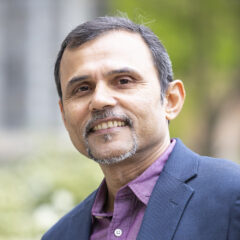(RNS) — If the current polling holds and Zohran Mamdani is elected mayor of New York in November, he will become the first South Asian, the first Muslim and the first African-born mayor of New York City.
Mamdani, a democratic socialist who won the Democratic Party primary in June, has primarily campaigned on helping lower-income New Yorkers afford to live in their city. But his faith, his easy relationship with his Muslim identity and his support for the pro-Palestine movement contributed to his victory as he brought together New Yorkers on the margins of the city’s economic life with those on the margins of its civic life — historically demonized Muslim communities.
Once his June victory made him the presumptive winner in the fall, the floodgates of dehumanizing language opened. A Republican congressman from Tennessee dubbed him “little Muhammad,” calling for his denaturalization and deportation. U.S. Rep. Marjorie Taylor Greene of Georgia posted an image of the Statue of Liberty draped in a black burqa, while South Carolina’s Nancy Mace said Mamdani’s win showed that New Yorkers had “sadly forgotten” the Sept. 11, 2001, attacks on the World Trade Center.
No group of New Yorkers, however, was more profoundly impacted by 9/11 than Muslims. A South Asian American Muslim with deep ties to the community, Mamdani knows the hate, violence and racial profiling that these communities endured in the aftermath of the attacks, which laid bare the conditional nature of the acceptance of Muslims, irrespective of citizenship, class or place of birth.
In the post-9/11 period, a new racial category of “Muslim looking” emerged that encompassed a wide swath of New York, and brown Americans across the country. Muslims, South Asians and Arabs became “forever foreigners,” and people who were deeply knit into New York’s culture suddenly morphed into totems of terrorism fears and suspicion.
Islamophobic vitriol against Muslims, of course, has a long history in the United States and Europe, but 9/11 intensified it in unprecedented ways. The Justice Department, the FBI and immigration enforcement agencies began sweeping Muslim neighborhoods, detaining approximately 1,200 Muslims nationwide. Most were immigrants considered of “special interest” because of their faith. The Justice Department ended up acknowledging that the “special interest sweeps” led to massive abuses, but very little success in unearthing terrorism.
Those sweeps were followed by more draconian orders. Introduced in 2002, the National Security Entry-Exit Registration System required men aged 16 or older from 25 designated countries (all but one of them Muslim-majority) who were on temporary visas to register at local immigration offices for fingerprinting, photographs and lengthy interrogations. Approximately 90,000 went through this process, and more than a thousand were detained and deported. The program essentially legalized Muslim suspicion.
In a Pakistani immigrant neighborhood on Coney Island Avenue in Brooklyn, visiting cards from the FBI, NYPD and immigration officials started appearing under residents’ doors, instructing them to call back. Young Muslim men in the neighborhood were soon detained, and their wives and mothers struggled to find out where the men were being held and on what charges.
Local Muslims avoided the neighborhood restaurants as the FBI agents started frequenting them. The local mosque emptied during Friday prayer as many immigrants returned to Pakistan or moved to Canada. Similar stories were shared by working-class South Asians in Queens, Brooklyn and the Bronx.
If he’s elected, Mamdani will inherit a police department that was on the front line of this War on Terror. In 2007, the NYPD released “Radicalization in the West: The Homegrown Threat,” a report claiming that young Muslims’ political and personal grievances led to deeper religiosity, which in turn led to radicalization and terrorism. Growing a beard, becoming religious, wearing Islamic clothing and getting involved in Muslim community activities came to be identified as early signs of radicalization.
The report was widely cited in congressional hearings and policy discussions as the most important framework to understand Muslim radicalization. Its real impact was only understood later, when The Associated Press published a series of Pulitzer Prize-winning articles that showed the NYPD’s systematic documentation of where Muslims lived, shopped, worked and prayed. AP’s stories showed how the department’s Demographic Unit, with the CIA’s help, had infiltrated Muslim student groups, put informants in mosques, monitored sermons and cataloged every Muslim in New York who adopted Americanized surnames.
New York Muslim leaders and civic groups challenged the surveillance regime at every step. Muslim community leaders and civil rights groups, such as the ACLU, NYCLU and CLEAR, brought lawsuits, including Raza v. City of New York and Handschu v. Special Services Division. Settlements in 2017 created greater civilian oversight of the NYPD and renewed a stricter adherence to Handschu guidelines — rules created in 1985 to limit the surveillance of political and religious activities. Most dramatically, the court instructed the NYPD to strike the 2007 report from its website.
As Mamdani’s rise is rightly seen as a reflection of the crisis of affordability in New York, it’s important to acknowledge how the communities once written out of the city’s civic life have now found new hope in his campaign. Mamdani’s campaign was preceded by others who challenged this exclusion. Prominent among them was Shahana Hanif, who was elected to the City Council from Brooklyn as the first Muslim woman member the same year Mamdani was elected to the New York State Assembly. Hanif has been articulate about how growing up in post-9/11 New York inspired her to run for office.

Sangay Mishra. (Photo courtesy of Drew University)
Mamdani is weaving these various threads of resistance into his campaign to imagine a more inclusive and just city where those at the margins of civic life, especially post-9/11, are visible at the forefront. While the city still has a long way to go to address the harms it has caused Muslim communities, Mamdani’s primary victory reflects the emerging power of civic and grassroots/working-class mobilization at this moment.
(Sangay Mishra is an associate professor of political science and international relations at Drew University and author of “Desis Divided: The Political Lives of South Asian Americans.” The views expressed in this commentary do not necessarily reflect those of Religion News Service.)







